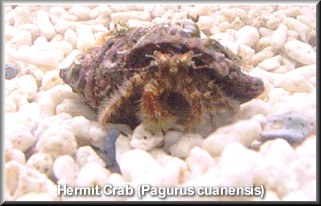 |
| Homepage |
| Index |
| News |
| Main Links |
 |
|
|
| ARTHROPODA |
| Uniramia (Insecta) |
| Chelicerata |
| Crustacea |
| Pycnogonida |
| CRUSTACEA |
| Branchiopoda |
| Branchiura |
| Cirripedia |
| Copepoda |
| Ostracoda |
| Malacostraca |
| MALACOSTRACA |
| Stomatopoda |
| Mysidacea |
| Cumacea |
| Isopoda |
| Amphipoda |
| Euphausiacea |
| Decapoda |
| DECAPODA |
| Caridae |
| Astacidae |
| Palinura |
| Anomura |
| Brachyura |
|
|
Hairy
Hermit Crab
 |
Common
Name(s):
Common Hermit Crab Scientific Name: Pagurus cuanensis Family: Usual Size: cm |
| Identification:
Hairy Hermit Crab by Luke Richards A rockpooling trip to Bembridge in April 2000 revealed something a bit special and unusual, and it arrived by accident. In the teeming rain I collected a weed covered rock from a deep rockpool, which was transported home by being rather crudely wrapped up in a plastic bag, and it was only when this attractive living rock was placed in the aquarium did a small Hairy Hermit Crab reveal itself. It turned to be a specimen of Pagurus cuanensis, which is rarely discovered between the tides.
The Hermit Crab wasn't occupying a shell for some reason, so I chose a suitable sized shell for it from a spare lying around in the tank, it soon vacated it without much hesitation. I isolated the crab from the main tank for a couple of days to study it closer, and also to avoid any possible risk of it being attacked by the Corkwing Wrasse, Symphodus melops, I had at the time. A Worm Pipefish, Nerophis lumbriciformis, also fell off the rock into the plastic bag. This Bembridge beach is probably the most easterly location where this small fish is common on the northern coast of the English Channel. There have been a few records from Sussex though. Behaviour The Hairy Hermit Crab appears to be a bit of a loner, it doesn't get involved in constant scraps that go on between the common Pagurus bernhardus, but prefers to keep out of harms way. The crab was only ever seen munching on seaweed, so initially I thought the Hairy Hermit Crab was a herbivore, however this theory went out the window when I recently noticed it eating the leftovers of a dead shrimp! Unlike the common Pagurus bernhardus which will readily snatch food from my tongs; the Hairy Hermit Crab used to shy away from this and usually hide. It took three months before it ventured out into the open area of the tank to snatch food from my tongs. Distribution and Bionomics Pagurus cuanensis
is reported to be common around the length of the British Isles, but it
is only rarely found on the shore, and this is the first rockpooling record
of this species I have received. There must be hundreds of millions of
small Common Hermit Crabs, Pagurus bernhardus, compared to each
one of this species discovered. It is a much smaller species with a carapace
only attaining a length of 16 mm compared to 35 mm of Pagurus bernhardus.
Therefore, it will only inhabit the small winkle-sized shells. In captivity
it is much hardier, especially in the summer months when it will survive
in uncooled aquaria.
Similar species: Pagurus bernhardus Breeding: Habitat: Bionomics: Range: Additional Notes: 16
April 2007
18
March 2007
The
fauna was sparse: the most newsworthy discovery was not made until later
when a small gastropod shell collected was
found to contain the small Hairy Hermit
Crab,
Pagurus cuanensis, one of
only a handful I have ever found between the tides.
It looked very strange at
first, like a small Long-legged Spider Crab, Macropodia
rostrata, living in a Dogwhelk, Nucella,
shell.
Links: Hermit Crabs for the younger student (NE Atlantic
species only)
Information wanted: Please send any records of this crab, with
location, date, who discovered it, how it was identified, prevalence, common
name and any other details to
|
|
Use these links if your are familiar with the scientific classifications of marine life |
|
|
|
News 2018 |
Membership Form |
|


